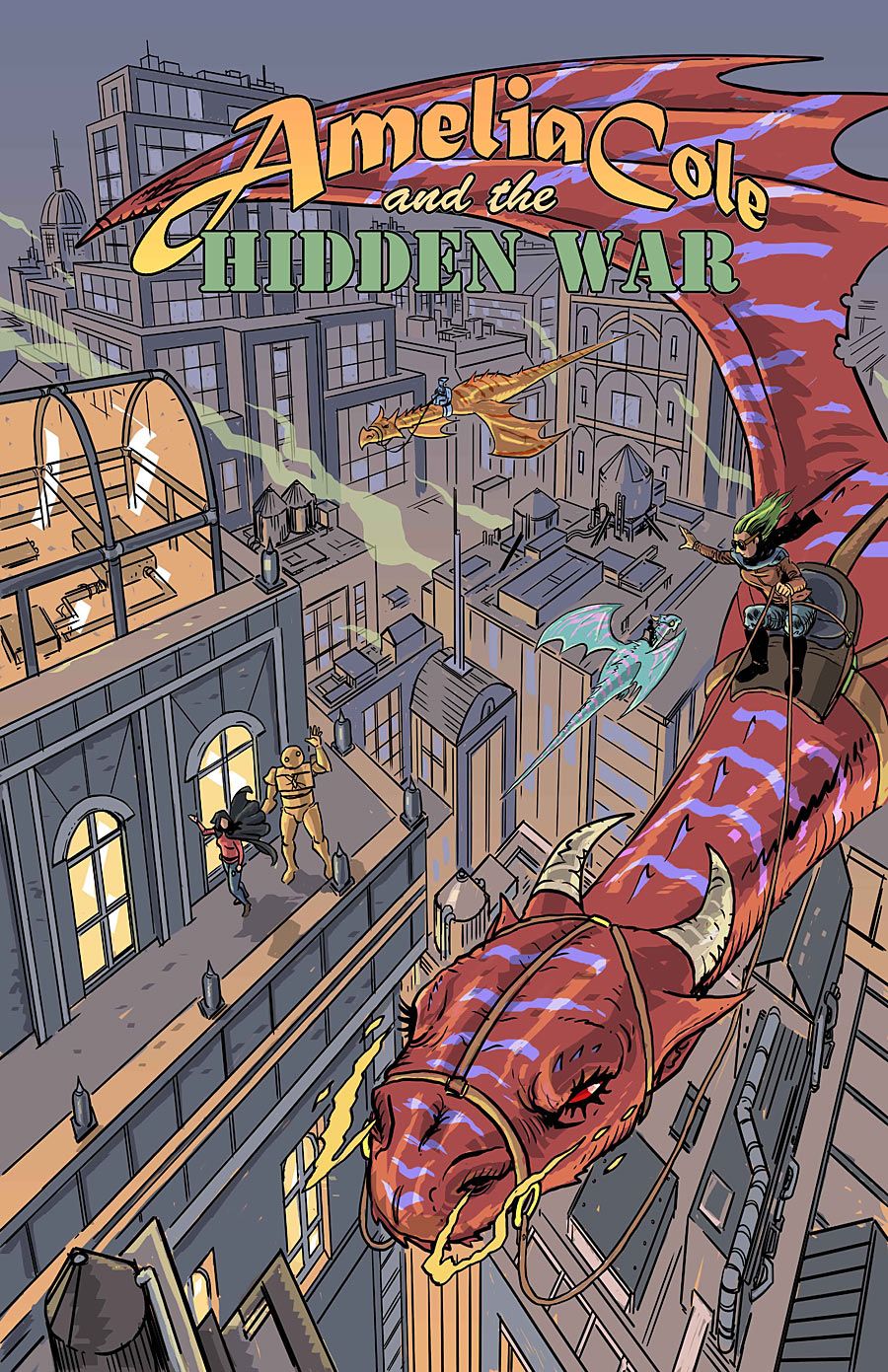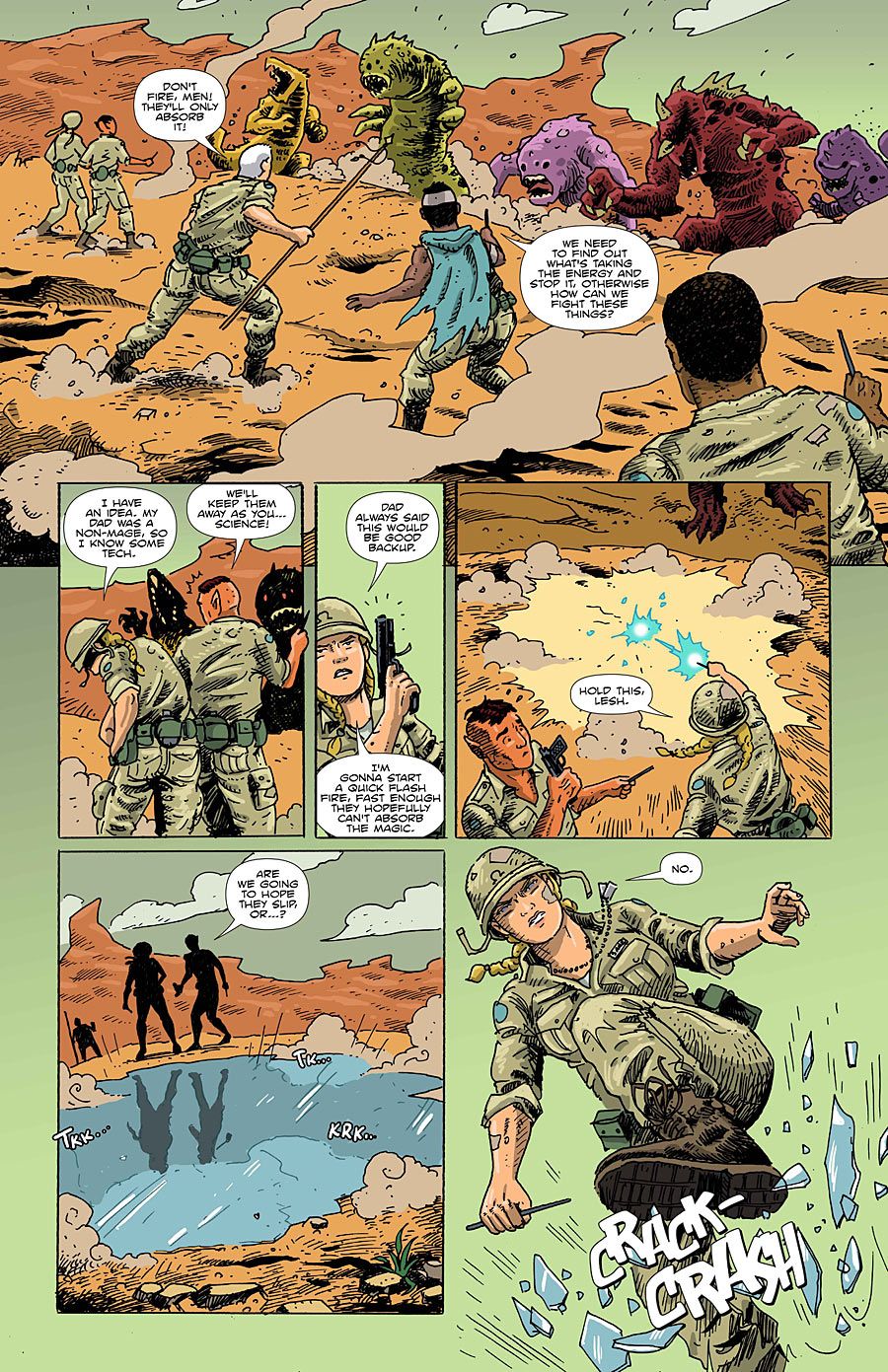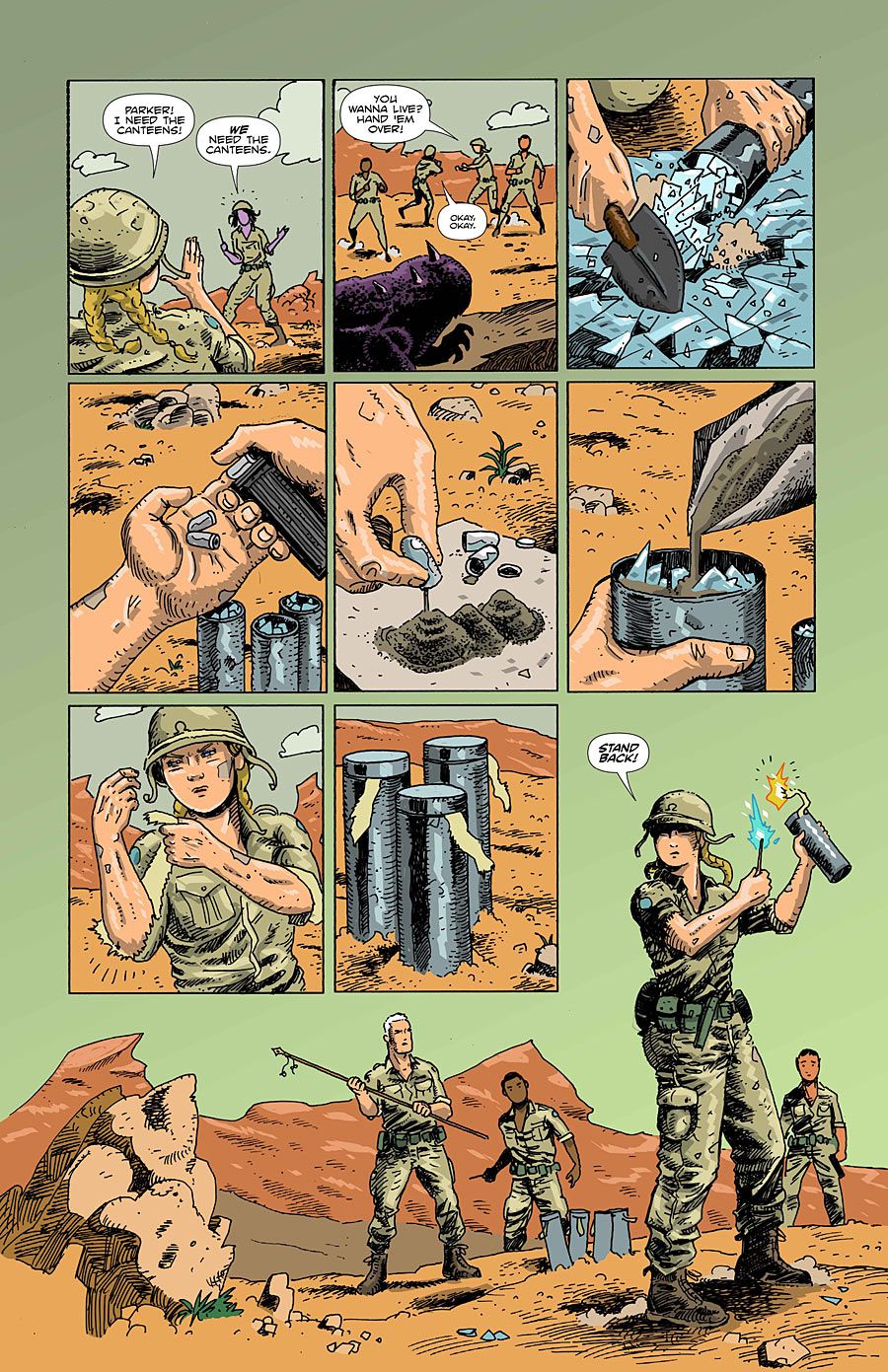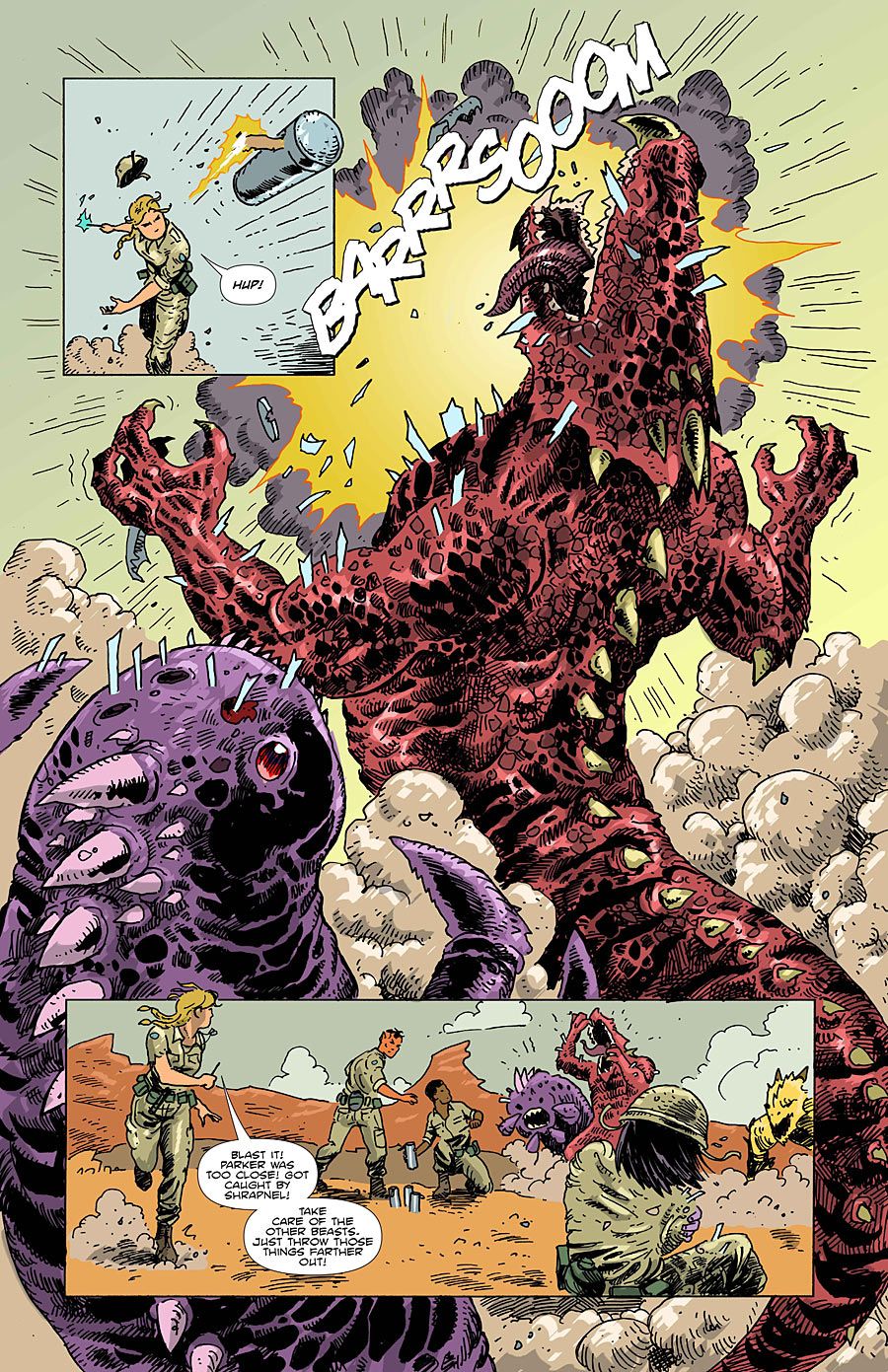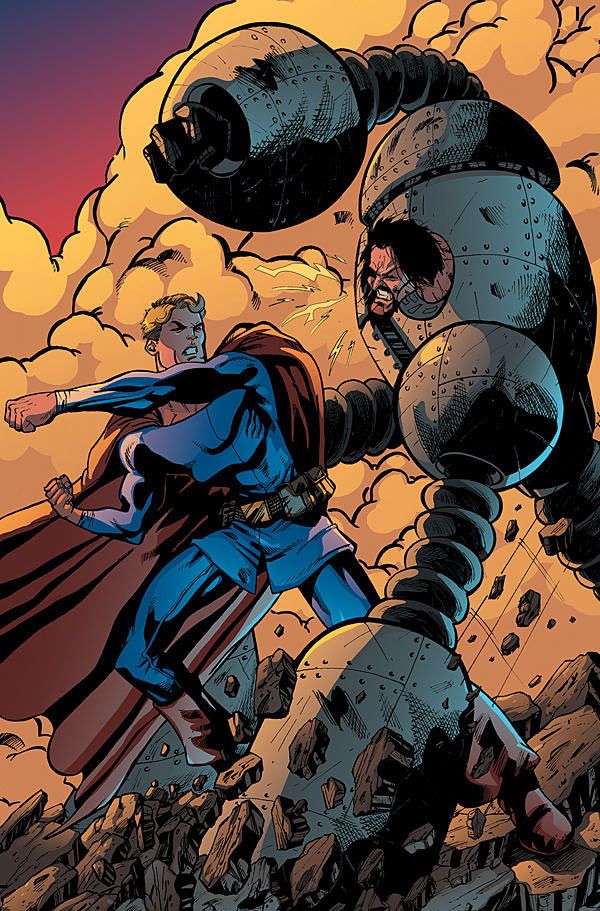Over the last two years Monkeybrain Comics has offered all sorts of comics featuring superheroes, magic, daring heists and... well, Renaissance fairs. One of the most well-known of their books, however, is "Amelia Cole," created by co-writers D.J. Kirkbride & Adam P. Knave and artist Nick Brokenshire, colored by Ruiz Moreno and lettered by Rachel Deering.
Kirkbride and Knave had a pretty spectacular 2013 as a whole, in fact, with their Dark Horse Comics miniseries "Never Ending" with artist Robert Love which began in November and concludes later this month. Amelia Cole has also made the jump from digital to print thanks to IDW Publishing, suggesting that there's a high chance 2014 will be the year of Knave & Kirkbride.
The writing duo sat down with CBR News in the fictional yacht that exists in all our minds to talk about their writing, the future of "Amelia Cole," the rise of digital comics and more!
CBR News: Firstly, let's talk about "Amelia Cole," your ongoing Monkeybrain series. For those unaware, what's the premise of the series?
D.J. Kirkbride: Amelia Cole is a lady who spent a good part of her young adulthood jumping between two different dimensions: a world of magic, and a world of science. She herself is a mage and figured she should use such cool powers for good, but she didn't feel like playing by the rules, which landed her in a lot of trouble. She ends up stranded in a third world, which is a combo of magic and science, where the mages are kind of in charge, and the non-mages are kept down a bit.
Amelia does her usual thing, and again runs afoul of the folks in charge while doing her best to do good and save the day -- for mages and non-mages alike. She also makes a new best friend, literally -- she creates an 8-foot-tall techno-golem named Lemmy who, while silent, gives her someone to talk to other than herself, and is also a big hero-type in his own right.
RELATED: Roberson & Baker Discuss Year One of Monkeybrain
Adam P. Knave: And throughout all of that big fun action and heroics is a solid touchstone of a coming of age story. Amelia Cole is a woman still learning to be the person she wants to be. She's still evolving. So whether it's a fight against a corrupt system, or a demon in a three-piece suit, she's someone who holds hope close and fights to improve life for everyone around her. We wanted to make a female led series that features a real human, you know? Someone that we could look up to but also still relate to. The type of person we both wish we could be and, at times, are afraid we are, because she isn't "One Thing." Like all good characters, she contains multitudes.
Amelia Cole has been going for two complete storylines now, and you're heading into your third as we speak. Did you expect for the series to have such a long, lasting run?
Kirkbride: We try not to have expectations, but we certainly have always hoped for a long run. There's something attractive about working on a long running story. Right now, we have up through this third series and then the following one tightly plotted -- and then we have enough ideas for about ten to twenty other volumes! Adam likes to plan super long term, and I have come to accept that he's much smarter than me, so I'm going along with it. The truth is, though, that we just love Amelia Cole the comic and the character.
Knave: I think we expected to do six issues and see where that took us. We now expect to do 30 issues and then see where THAT takes us. Hopefully to 60 and so on. I do like long term planning, it's just fun. But also working with D.J. and Nick, as well as Ruiz Moreno on color assists and Rachel Deering on letters is addictive. When you get to have as much fun as we do, you never want to stop. And that's the real answer I suspect: We expect to keep the book going as long as we can.
As time has gone on, how do you think your writing has changed and developed? Has making the series gotten easier or harder as you've moved deeper and deeper into Amelia's world(s)?
Knave: I think we're both getting better at this writing stuff. There's nothing like writing to make you a better writer. I know that sounds silly, mundane even, but just digging into the process helps you understand it. Of course we also both do research, writing-wise. I'm not talking "What sort of ships did the French Navy have during the French-Spanish War" but just reading and watching things and listening to music to see how other people develop character and tell stories for tricks and bits and bobs we can learn from.
Working on the book itself has gotten easier, for me at least. We're a well-oiled machine by now. D.J. and I sit around and chat it up, hero-style (for the record: Hero-style chatting is where we are both on phone, but wearing capes and masks) and plot up the next bit of story. Then we pass it to Nick and he makes notes and then we start writing. But this world, these characters -- we know them so well it's just joy to work with this material.
Kirkbride: Indeed! While practice doesn't make perfect, because perfection is only possible for burritos and maybe certain pizzas, it definitely makes better. It's also funny to look back at where we started compared to now. We started getting into the groove a few issues in, and since then it's been... still really hard a lot of the time. Because we never want to just get in a rut, so we're constantly surprising each other and Nick and trying to keep the series fun.
Taking risks and weird left turns with the story has paid off, so what's happened is we're both less nervous about taking risks. We've become more confident as writers, but not cocky. That's an important distinction, too. We want to make sure to always stay true to the characters, the worlds, and ourselves. And we want to amuse Nick, because when he responds happily to our stories, it makes us feel warm and fuzzy inside.
Where is Amelia currently? As you head into the third story, what can readers expect to find?
Kirkbride: We try to make the book very reader friendly, from the "previously" paragraphs at the start of each issue to a general inviting tone and feel for each story. Having said that, it's so easy for readers to catch up, being that every issue is available for the cheap on comiXology, so we don't feel we have to worry about that too much. I also remember being a kid and just snagging whatever comic looked cool on the spinner rack and diving right in, regardless of whether it was in the middle of a storyline. It's kind of fun. Right now, Amelia is just... in deep trouble. She's always in trouble. And hungry.
Knave: Amelia herself, going into the third arc, is in yet another surprising new place. She's actively questioning power and that opens doors that maybe shouldn't be opened. You can't expect to shake the foundations of the power structure you're working with, without causing a bit of a mess. Amelia is just confident (maybe over confident at times, she gets that way) that she can handle it. She'll need help if this is going to work out. But then -- who says it's going to work out?
How do you view her as a character, and has that changed over the last few years since you created her? What do you think motivates her?
Kirkbride: Her motivation is something we think should be simple, but seems to be presented as incredibly complicated and strange in these days of angst and reluctant heroes and 24-hour brooding: if you can help out, help out! She's a genuinely good person who wants to help others... and she's also very fallible and impetuous and kind of hot headed, so that doesn't' always work well for her. Over the course of the series, she is growing and learning to think a little before she leaps. That was part of our plan, and what we have coming up for her will hopefully be surprising but make sense in hindsight to readers. It's exciting to basically be able to do whatever we want and let the story guide us.
Knave: Amelia, as a character, is our guiding light in the story. When plotting we have tossed out ideas that, while fun, weren't true to how the characters would react. Never more so than with Amelia. She's a woman of conviction, and at times that holds true when she's wrong. But she's also human and can make mistakes. The trick with Amelia, though, is that she's willing to fix her mistakes, and learn from them. Her motivation is to do the right thing. It really is that simple, at the core.
You very quickly set up the various worlds that Amelia keeps finding herself in, and the characters who live in there. Do you think you gravitate towards this kind of storytelling, where you get to build a world of your own -- and then smash it up and cause chaos?
Knave: I know I do. I come from a background of prose and so my first instinct is always "Build a world, then build the right hammer. Apply hammer to world." We did it as kids, didn't we? It's play. We take it seriously and approach it seriously but we also are mindful to not lose the fact that it is a thing to be played with and have fun with. Really all storytelling is a world and a hammer.
The same concepts would apply if we were ever lucky enough to write, say, "Dazzler", or a Turbo Teen tie-in comic. The world is there already, sure, but we still have to build it back up for new readers. It's just a question of existing framework -- you would think. But then remember that even Amelia's world has ways you can identify it, tiny short hand touches to make things relatable. That's a framework as well, and we use it to build on, and later smash into tiny tiny pieces gleefully. This is giving you horrible insight into how I play with LEGO, isn't it?
Kirkbride: This is more in Adam's wheelhouse. My instinct is to take things slow and be cautious. It's been fun working on a book like this with this team because it's taken me out of my comfort zone. The fun thing now is when I suggest something I never would have considered when we first started and occasionally take Adam aback -- then he just makes it bigger. And then he smashes it, and we rebuild it even bigger than that. Also, I don't let him borrow my LEGOs anymore. Not because of the smashing, but because I'm afraid he'll choke on one.
Knave: Worse, I step on them! Is there anything worse than stepping barefoot onto LEGO? It's a pain... I have broken both my legs and a few toes. I have been hit by bricks and more than one baseball bat. Stepping on LEGO is honestly comparable to that. What is it made of? Painium? Are they pure Painium, to torment me so?
Do you have in your mind specific rules for how magic works, and how everything fits together?
Knave: Oh the talks we had about magic! Lo, the discussions! Verily, the -- yeah we talked a lot about it, but one of the major points was that we don't want to sit and explain it to the reader. We want it to make sense through use, so the reader can put it together themselves. There's reward there, and also a sense of weight. Makes the universe feel lived in when the rules unfold over time and everything makes sense.
Kirkbride: There is a fine line between making the magic make sense in terms of the story, and getting caught in this web of rules. Sometimes it gets overly complicated, and then we realize we're all making it up and relax a bit. In the end, we try to find a balance between giving the book its own internal logic while also just having a lot of fun and making Amelia and her pals do really cool things.
Artist Nick Brokenshire in particular seems to have made himself completely at home with the series, sneaking in at least six jokes or sight gags per page. Was this something you expected from him when he first came on? How has it been to co-create a series with somebody like Nick?
Kirkbride: Nick's just as in charge of how the book develops as we are. Right from the get go, we knew he'd make it look pretty and read very clearly, but, honestly, we had no idea he was this funny. It started kind of subtle, with some joke book titles in issue one, and a couple background shop names he'd ask us if we'd caught to sight gags upon sight gags. It's great, though, as the series gets a little deeper into some kind of dark conspiracies, that's been toned down a little -- and yet is still very much a part of the book, and an integral one. I imagine him giggling to himself as he draws sometimes -- at least I kind of hope he does, because that's what I do when I write. You do, too... right, Adam?
Knave: I totally do! I am not a guy who has ever had that moment of "I wrote this scene and it made me cry," I'm just not that guy. Normally. But working on "Amelia" I have read drafts of scripts that D.J. works on and fist pumped. I've read some of Nick's notes and laughed at loud and shouted "Yes!" to an empty room. So you know, I'm losing my damn fool mind here.
What's your experience been of working with Monkeybrain so far?
Knave: Pure joy. Look, I've read thousands of interviews and you won't get people often saying, "Well, I sure do hate working for these folks kind enough to publish my work. Boy howdy, do they ever suck!" so there's a sense of "of course they're gonna say they like it" but I need you to understand -- we love it. 100%, will take polygraph tests to prove it, love working with Monkeybrain. [Monkeybrain co-founders] Chris [Roberson] and Allison [Baker] are such warm and wonderful people, always helpful and present and smarter than a sack of smart people -- working with them is easy. It's what publishing should be, really. And by that I mean -- run by those two hep cats.
CCI: Monkeybrain's Roberson is a "Poor Publisher"
Kirkbride: Chris and Allison have created something very special with Monkeybrain. They take chances on fun premises by creators they like, regardless of how "famous" said creator is, and it's paying off. To have "Amelia Cole" be part of such a great company run by folks we genuinely like is truly something special. Also, Chris taught me how to properly tie a necktie at last year's Emerald City Comic-Con, so, yeah... Monkeybrain's pretty cool.
Do you think digital comics are starting to have an effect on perhaps not just the comic book marketplace -- but on the way people write comics and tell stories?
Knave: Digital comics are a huge tool with a still-untapped potential. We do what we can, we all do, but there are so many things to be learned. Alex de Campi did "Valentine" and broke a lot of the thought-rules for how this works and now Thrillbent uses a lot of that and we use other stuff and we've reached a point where "digital" is like "print" in that they mean far more than a single thing. It's exciting. We're adapting and finding new ways to go. Issues being 12 pages long, but feeling like complete issues was something that hadn't entered into our heads when we started. But now we're good at it. We thought we'd do a "Hellboy"-style series of miniseries with Amelia, but learned that with comiXology we are better served by numbering straight through. We can adapt and adjust incredibly fast, for publishing, and use that as often as possible.
Kirkbride: Yeah, being able to think fast and make course corrections almost on the fly has been huge, especially for us, as this was our first ongoing series after working on anthologies. Another factor is that, honestly, we couldn't have afforded to print single issues of the book, and if we'd gone to print with another publisher, there's a chance it wouldn't have found an audience.
There is risk with any endeavor, but digital has allowed us to build our readership as we go on. The fact that the book will never be out of print means that, say, someone finding out about the series because we're doing this interview can just go check it out right from the beginning. It's changing the rules, but there is no spoon. Also, we know kung fu.
Just ending this month is another series you're co-writing -- "Never Ending", a miniseries published through Dark Horse. How do you juggle co-writing together? How does that process work for you?
Kirkbride: It always starts with us having general conversations and hammering out the basics of a story. Once we're happy, we make sure the artist is interested in drawing it and also take suggestions because we'd be silly not to. Then one of us does a rough beat pass of an issue. Then the other scripts that and does a beat pass of the next issue. Then the first one revises the script, scripts the beat pass, and does the next beat pass, and then -- basically, by the end, we don't know who wrote what, and it doesn't quite sound like either of us.
Adam is a writer with his own style. I'm a writer with my own style. And then there's this beastly combination of us that is pretty much a totally separate writer. It's kind of creepy.
Knave: It really is sort of creepy. I am constantly amazed by the D.J./Adam writing when I stop and look at it. There are choices I never would have made solo but are so perfectly right I want to know how they happened. But we work so closely and so fast, there's no answer to it. It just comes out of this brainmeld we have at this stage and surprises us both.
What's the concept of "Never Ending"? Were you deliberately looking to come at superhero comics from a different angle when you came up with the premise?
Kirkbride: We love superheroes, but we'd never written one. Amelia is heroic, but she doesn't wear a costume or anything. This was very much a chance to do a superhero story with Robert Love, an artist who can draw some of the best superheroes around, and it was both daunting and exciting. The truth is, though, that the book is more about dealing with outliving your loved ones and finding purpose after you've lost what you'd always thought was the point of life.
Doing this with a guy who can fly and punch giant robot suits and fight aliens and whatnot makes it fun and visually exciting for a comic book, but that's not totally what it was about. We are also aware that superheroes have been studied from almost every angle imaginable. "Never Ending" is more about this specific character in this specific circumstance, not about making a broad statement about the superhero genre as a whole. It's been fun seeing the reactions to what really started out as a very personal story about being as afraid of life as of dying.
Knave: Whereas, since D.J. came to the table with the personal side nailed down so perfectly, I used it as an excuse to play more with superhero stuff in a larger sense. We each brought bits and, again, merged them, swirling them around until the end result is something neither of us would have been able to do solo. But yeah, I knew we were going to do superheroes and who knew if we would ever get the chance to do it again, so I wanted to bake in some thoughts on the genre, just in case.
Again, this is a book which is focused on the lead character. When you're putting a story together, how do you go about putting a character like Charles together, and turning him from an idea into a character of his own?
Knave: Making a character out of an idea is one of those things. Internally it's just "Well, you do it, you know?" and it happens. Externally I'm sure it looks like madness. We tell each other stories. And then we tell them again, adding and removing ideas. It's like sculpting, I think. We start with a lump of rock and slowly reveal the form hidden inside it through experimentation and experience. I don't know I've never sculpted anything. Well, not since 4th grade and play-doh.
Kirkbride: The interesting thing about "Never Ending" as opposed to "Amelia Cole" is that it, well, um... has an ending. It's a finite story, so we developed Charles specifically for it, knowing we'd have about 72 pages to tell his whole tale. We have less time to show off as many dimensions and asides as we do with Amelia, so we have to be really concise. The sculpting analogy is apt, as is how I eat a piece of cake. I start with the frosting, and then... I think I'm just hungry. Sorry.
You mentioned working with artist Robert Love on the project, somebody you both seemed excited about collaborating with. What does he bring to the story as an artist? What about his work made you want to work with him?
Kirkbride: Robert can draw some really great superheroes and big action, which made him an appealingly odd fit for this kind of story. Initially I saw this done in a quirkier, more indie comics style, but when we started talking to Robert about working together, suddenly it clicked. This is an emotional, quiet little story at its heart, and having it drawn like a more classic superhero comic helped it feel more exciting and balanced how introspective it is. He really helped us find the tone and make it a better book. Also, he's one of the nicest guys in the world.
Knave: The whole team is. Robert is a sweetheart, Heather Breckel, who colors the book is patient and kind, Frank Cvetkovic letters the hell out of it and puts up with our madness, and Felix Perez, Jr. has added some great texture with is inks on the third issue -- we're lucky guys, getting to work with all these amazing folk.
What else do you have coming up? Where can we see you both next?
Knave: Soon "Amelia Cole" issue #13 -- the start of arc 3, "The Enemy Unleashed," hits. In May (I think) "Amelia Cole and the Hidden War," the second physical trade drops. Also in May Free Comic Book Day happens, and, in the CBLDF offering, we will have an exclusive two-page "Amelia" story. It has tacos.
This summer the "Never Ending" trade hits, as well. Outside of work with D.J., in March the first volume of my other Monkeybrain book (co-written with Sean E. Williams, drawn by Andrew Losq, and lettered by Frank Cvetkovic) "Artful Daggers" sees print by IDW. Past that -- secret plans. Oh yes.
Kirkbride: Yep, so, Amelia is showing up on Free Comic Book Day! What a great time. We're so happy to be a part of that. I have some stories and projects in the works, but nothing that I feel comfortable talking about right now, for fear of cursing myself. I sincerely hope to have some other comics announced and maybe even released in 2014. Fingers crossed!
"Never Ending" #3 is on sale Jan. 29 from Dark Horse. The first twelve issues of "Amelia Cole" are available now digitally on comiXology, with the first trade paperback available from IDW.


